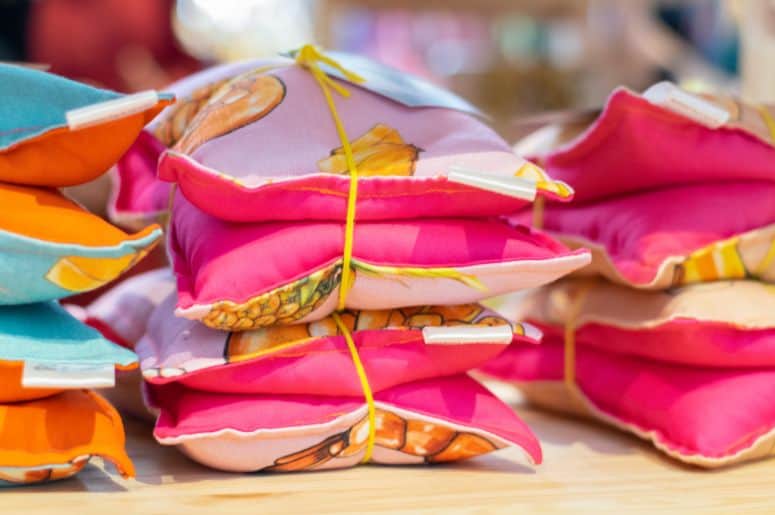Embrace Handmade Warmth: Crafting a Perfect DIY Wheat Bag
Hey there, crafty parents and cozy comfort seekers! Are you ready to dive into a fun and fulfilling DIY project that not only soothes sore muscles but also heats up those chilly nights? Well, buckle up, because we’re about to guide you through the delightful process of creating your very own homemade wheat bag! These cuddly companions are perfect for snuggling, easing tension, or simply providing a cozy touch to your family’s day-to-day routine.
What You’ll Need to Begin
Before we embark on our DIY adventure, let’s make sure we have all our supplies on deck. Here’s a quick checklist to help you prepare:
- Natural fabric – Think of cotton or linen for breathability and comfort.
- Wheat grains – These are the magic ‘beans’ that will hold the heat.
- Sewing essentials – A sewing machine or needle and thread will do.
- Scissors – For crafting and cutting your fabric to size.
- Funnel or spoon – This will help you pour the wheat in without any mess.
- Lavender or essential oils (optional) – If you fancy a touch of aromatherapy.
Picked your favorite fabric? Got those grains ready? Awesome! Let’s move on to the next cozy step!
Step-by-Step Guide to Making Your Wheat Bag
We know you’re excited to get started, so we’ve broken down the process into simple, follow-along steps to ensure your wheat bag turns out just perfect.
Step 1: Preparing Your Fabrics
First things first, let’s get your fabric ready. For a standard size wheat bag, cut two rectangles of fabric measuring around 20 inches by 8 inches; this will give you a nice, manageable size. Feel free to adjust based on your preference. Don’t forget to wash and iron your fabric beforehand to pre-shrink it and make sewing a breeze!
Step 2: Stitching It Together
Lay the fabric pieces right sides together and sew a straight stitch along three edges, leaving one of the shorter sides open. Keep a seam allowance of about half an inch to ensure your wheat bag is secure. If you’re new to sewing, don’t fret; just keep your stitches even, and you’ll do great.
Step 3: Filling with Wheat
Once you’ve stitched three sides, turn your fabric right side out. Here’s where the funnel or spoon comes in handy: slowly fill the bag with wheat grains, leaving enough room at the top so the bag isn’t too firm and can still mould to your body. A good rule of thumb is to fill it three-quarters full.
Step 4: Finishing Touches
Now that your DIY wheat bag is almost ready, it’s time to seal it shut. Fold the open edges inward, creating a neat seam, and carefully stitch it closed. Add a few drops of your favorite essential oils or some dried lavender to the wheat before sealing if you’d like an extra element of relaxation.
And voilà! You’ve just crafted a warm, comforting treasure that’s ready to soothe tired muscles or warm up those frosty toes. Before first use, heat your wheat bag in the microwave for 1-2 minutes on high (make sure to check your microwave’s specifications). Always remember to never overheat your wheat bag, as this can pose a fire hazard.
Creating your own wheat bag is not just about crafting something practical; it’s about pouring a bit of love and care into an item that provides comfort to your loved ones, echoing the warmth of your affection in its embrace. So, snuggle up, enjoy the toasty goodness, and remember to check back for more fun and fabulous DIY projects that bring coziness into your home.

5 Essential Tips for Parents When Making a DIY Wheat Bag
Creating a wheat bag is simple and enjoyable, but as with any DIY project, it pays to be prepared. Here are five key points to keep in mind before you start crafting:
1. Choosing the Right Fabric
It’s important to select a fabric that is not only cozy but also durable enough to withstand the heat. Natural fabrics like cotton and linen are ideal as they are breathable and won’t irritate the skin. Avoid synthetic fabrics, which may melt or release toxic fumes when heated.
2. The Quality of Wheat Matters
Invest in good quality, triple-cleaned, and dry wheat grains, commonly found at craft stores or online. Properly cleaned wheat will have less dust and debris, reducing the risk of allergies or discomfort when using your wheat bag.
3. Sewing Safely
If you’re involving children in the crafting process, emphasize sewing safety. Use sewing machines with caution and guide little hands when handling needles and scissors. This can also be a great opportunity to teach them basic sewing skills!
4. Heating Instructions
After making your wheat bag, it’s crucial to understand how to heat it properly. Never exceed the recommended time and check the wheat bag’s temperature before use to avoid burns. It’s a good idea to include a written note of the heating instructions with the bag.
5. Cleaning and Maintenance
A DIY wheat bag will last longer if it’s properly taken care of. As it cannot be washed, using a removable cover that can be washed regularly is a smart way to keep it clean and hygienic. Always store the wheat bag in a cool, dry place to prevent mold or unpleasant odors.
By keeping these tips in mind, you’ll be all set to create a beautiful, homemade wheat bag that your family will treasure. Don’t hesitate to unleash your creativity and personalize your wheat bag—with various fabrics, patterns, and scents, each creation can be as unique as your family. Happy crafting!
Storing and Caring for Your DIY Wheat Bag
Once your wheat bag project is complete, proper storage and care are essential for longevity. Here are some additional tips to ensure your handmade wheat bag can be enjoyed for many cozy moments to come:
- Always let the wheat bag cool completely before storing it away.
- Avoid placing heavy objects on top of the wheat bag, as this could cause the grains to crush and lose their heating qualities.
- Consider sewing a separate washable cover for ease of cleaning. Simply slide the wheat bag into the cover when in use and then wash the cover as needed.
- If the wheat bag starts to smell musty, you can add a few drops of essential oil for a fresh scent before heating it in the microwave.
- Never dampen the wheat bag as moisture can lead to mold. If it accidentally gets wet, dry it thoroughly in a well-ventilated area or in the sun.
Armed with these handy storage and care tips, you’ll ensure your DIY wheat bag remains a cherished accessory for warmth and relaxation in your home. Remember, every stitch and grain added to your wheat bag weaves a story of comfort and craftiness—a lovely manifestation of your care for your family.
Ready to create your DIY wheat bag? Let’s get crafting and cozying up!
See more great Things to Do with Kids in New Zealand here. For more information see here
Disclaimer
The articles available via our website provide general information only and we strongly urge readers to exercise caution and conduct their own thorough research and fact-checking. The information presented should not be taken as absolute truth, and, to the maximum extent permitted by law, we will not be held liable for any inaccuracies or errors in the content. It is essential for individuals to independently verify and validate the information before making any decisions or taking any actions based on the articles.




